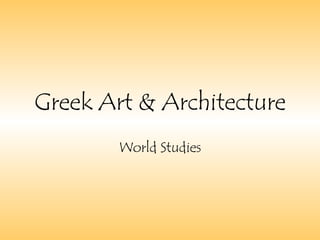Greek Art & Architecture
- 1. Greek Art & Architecture World Studies
- 2. Three Types of Greek Columns Doric Column Ionic Column Corinthian Column
- 5. The Parthenon. What type of columns do you see?
- 6. Temple of Nike Athena What type of columns do you see?
- 9. What influenced Greek Art? What was occurring in the world around them at the time? End of the Persian Wars Economic Wealth generated from Delian League Desire to rebuild and glorify Athens
- 10. Glorifying Athens Pericles wanted to glorify Athens. He funded the building of the Parthenon on the acropolis of Athens.
- 11. Order, Logic & Reason Greek philosophers emphasized order, logic, and reason. The Athenians emphasized order, logic and reason in their art.
- 12. Order and Symmetry The Temple of Athena Nike (Victory). The columns are in proportion and symmetrical. The Parthenon sits on the acropolis of Athens.
- 13. Do you recognize this building? This is the Lincoln Memorial in Washington DC. We have borrowed many of our ideas about architecture from the Greeks. Supreme Court
- 14. Greek Sculpture Do people really stand like this? Is this statue realistic? This is an example of sculpture from the time before the Classical Period.
- 15. Order and Logic in Greek Sculpture This statue is much more realistic. Notice that the man is standing in a realistic pose. His body parts in in proportion with one another. The Greeks celebrated the ideal human form.
- 16. More Classical Sculpture Here is another example of Classical Greek sculpture. The young man is visually pleasing yet he shows no emotion. The Greeks celebrated human form, yet believed that showing emotions was a sign of being uncivilized.
- 17. End of the Classical Period Review Question: What values and ideas of Classical Greece are reflected in the art and architecture of the time? Alexander the Great expanded Greek culture by building an empire that expanded into Asia Minor, Persia, and Egypt. After the death of Alexander, a new culture called Hellenism was formed. Hellenism was a blend of Greek and eastern (Persian) culture.
- 18. Hellenic Art Hellenic art was different. Greeks experimented with their style. It was grand and built on a larger scale than Classical art. The Temple of Zeus is very big.
- 19. The Colossus of Rhodes The Colossus of Rhodes is one of the Seven Wonders of the Ancient World. It was located in Southwest Asia Minor on an island called Rhodes.
- 20. Examples of Hellenic Art How is this man different from the statues we have seen in the Classical Period? Hellenic art portrayed ordinary people in everyday situations. Hellenic art took a more worldly perspective. “ Dying Gaul”
- 21. Hellenic Art Continued Winged Victory of Samothrace Statue of Old Woman




















